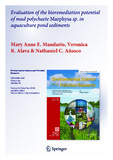Evaluation of the bioremediation potential of mud polychaete Marphysa sp. in aquaculture pond sediments
Share
Abstract
Organic enrichment from aquaculture could alter the chemical composition of the fishpond bottom by increasing the levels of organic matter (OM), sulfur (S), iron (Fe), and lower pH of the sediment. Polychaetes can contribute to the nutrient cycling and remediation of polluted sediment. A laboratory experiment was conducted to test the remediation potential of small and large mud polychaete Marphysa sp. introduced to two types of fishpond sediment. Initially, Sediment A had lower OM, S, Fe, and higher pH than Sediment B. After 30 days, in Sediment B, large polychaetes significantly decreased the OM level (27%) while both small and large polychaetes promoted significant decreases of S (71%) and Fe (70–73%) in both sediment types. The increase of sediment pH was promoted by the presence of polychaetes (0.53–0.69) although pH level in small polychaete was not significantly different with the no polychaete treatment. Regardless of polychaete treatment, the pH level of Sediment B (1.04 ± 0.10) was significantly improved than that of Sediment A (0.17 ± 0.02). In both sediments, large polychaetes (95%) had better survival rates than small polychaetes (73%). These findings reveal that large Marphysa sp. can significantly improve sediment quality by decreasing the levels of OM, S, and Fe and improve pH level to a more basic form without compromising its survival. Large polychaetes are recommended to be used as bioremediators of organically enriched aquaculture pond sediment.
Suggested Citation
Mandario, M. A., Alava, V. R., & Añasco, N. C. (2019). Evaluation of the bioremediation potential of mud polychaete Marphysa sp. in aquaculture pond sediments. Environmental Science and Pollution Research , 26(29), 29810-29821. https://doi.org/10.1007/s11356-019-06092-z
Subject
Taxonomic term
Collections
- AQD Journal Articles [1249]

